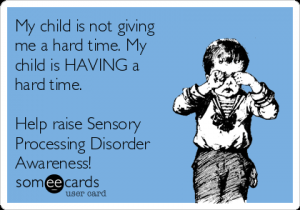My Spinning, Running, Anxious Child, Is it a Sensory Processing Disorder?
My Spinning, Running, Anxious Child, Is it a Sensory Processing Disorder?
We all have a sensory processing system. It means all our five senses (hearing, touch, taste, smell and vision) receive information from the environment around us and transmit this information to the brain to make sense of it. There are two additional hidden senses called the vestibular sense and the proprioceptive sense that are crucial to our daily lives.
The vestibular sense gives us a sense of balance and position in space as in “You are Here” while the proprioceptive sense is body awareness or knowing where our body parts are in relation to each other.

The vestibular system helps you to balance and know whether we are moving forward, backward, bending or so on without falling. The best way to check it is spin as fast as you can and suddenly stop! The tiny currents go on for a bit giving you the feeling that you are still spinning but in the opposite direction and your brain compensates by causing you to fall or feel dizzy. This gives you awareness of your most dominant sensory system- Vestibular Sense. Anatomically, It is located in the inner ear, almost behind your eyes.
A lot of children with developmental delays have Sensory Processing Disorders (SPD). Parents of kids with SPD lot of times report that their kids like to spin, run and climb. Let us know a little more about SPD.
The proprioceptive sense receptors are located in the muscles, joints and ligaments of our body and continuously send information to the brain about our body’s position when we are not moving. How do we know it is working?! Just shut your eyes and move your hand away from your body and then move it behind your back, lay it on your knee, and touch your head. How can your body do it without your eyes guiding it? It’s the proprioceptive sense.
All the above 7 senses make up the sensory processing system. Sensory processing or sensory integration (both are same) is the basis for learning. The brain processes this information and helps us take the next step. For E.g. When I see a school bus I recognize it by its colour and name. It also connects me to the previous memories of me travelling in an Army Truck to school feeling the wind on my face and the sight of a school bus creates a pleasant memory and happy feeling for me. At the same time if it’s a person who was bullied on the school bus it will generate an unpleasant feeling or memory!
The sensory system starts to develop in the womb and continues to develop throughout our lives. During the early childhood years, the nervous system is in hyper-development and sensory integration is refined through typical childhood activities.
Click on below link for more information
Some other resources for parents to read about SPD are,
-
Sensory processing for Parents: From Roots to Wings: Judith E Reisman
-
The Out of Sync child Video: Carol Kranowitz
-
Tools for Students: Diana Henry
-
Tools for Teachers: Diana Henry

SPD is considered a neurological impairment and may co-occur with ADHD or Autism Spectrum Disorders. But it some case it might be due to premature birth, lack of sensory exposure and environmental factors. There has been a rise in children getting diagnosed with SPD due to more awareness and also our lifestyle changes. Over the last 20 years, we have become an indoor society and our children are raised indoors with limited play time and activities that provide a healthy sensory system development especially from birth to two years of age.
Some of the characteristics of SPD include the following:
-
Inability to play in the park or playground with various equipment (Slide, swing etc.) and playing with new toys
-
Difficulty in Playing in a group situation
-
Emotionally Immature
-
Severe Meltdowns
-
W – sitting position and toe walking
-
Speech-Language Delay
-
Slow reading or academic abilities
How do we diagnose if a child has SPD?
There is no blood test or chromosomal test to detect SPD. Usually, a child’s behaviours are profiled in terms of the different sensory systems using checklists and observations by the Occupational Therapist. Occupational Therapists are trained professionals who are the ambassadors of your child’s nervous system’s processing of information and actual functional abilities. The occupational therapist will give therapy sessions that are play-based yet challenge your child’s body to process and react to different visual, touch, proprioceptive, vestibular and auditory information.
Reference: The Sensory Processing Disorder Answer book: Tara Delaney
This article has been written by Namrata Pai, Founder Director of Magpie Speech & Language Intervention Services, Bangaluru, India.
Sensory Processing Disorders
If you wish to know more about Speech Therapy, kindly contact us at info@1specialplace.com
https://therakonnect.com/appointments/book/1specialplace
For more ideas check out our other blogs https://1specialplace.com/news/
- Addressing the Silent Struggle in Special Needs Children - December 22, 2023
- Swallowing Difficulties: A Comprehensive Guide - December 12, 2023
- 6 Simple Steps to Enhance Speech Clarity and Connect with Confidence - November 3, 2023


Leave a Comment
(0 Comments)